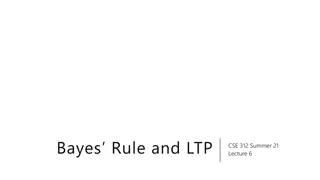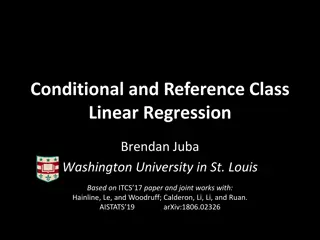Conditional Probability and Bayes Theorem
Conditional probability relates the likelihood of an event to the occurrence of another event. Theorems such as the Multiplication Theorem and Bayes Theorem provide a framework to calculate probabilities based on prior information. Conditional probability is used to analyze scenarios like the relati
1 views • 5 slides
Conditional Statements in Logic
Conditional statements in logic involve connecting statements with an "if-then" structure. The truth of the conclusion is dependent on the truth of the hypothesis. Explore examples, truth tables, and logical equivalences to grasp the concepts of conditional statements.
2 views • 26 slides
Conditional Clauses in English Grammar
A conditional clause is a type of adverbial clause in English grammar that states a hypothesis or condition using a conditional clause in the simple present and the main clause in the future tense. This type of clause uses modal verbs like would, should, could, will, may, might, or can. Conditional
4 views • 6 slides
Conditional Probability and Independence in Statistics
Conditional probability and independence are essential concepts in statistics. This lesson covers how to find and interpret conditional probabilities using two-way tables, calculate probabilities using the conditional probability formula, and determine the independence of events. Through examples li
3 views • 15 slides
Foundations of Probabilistic Models for Classification in Machine Learning
This content delves into the principles and applications of probabilistic models for binary classification problems, focusing on algorithms and machine learning concepts. It covers topics such as generative models, conditional probabilities, Gaussian distributions, and logistic functions in the cont
0 views • 32 slides
The Second Conditional in English Grammar
The second conditional in English grammar is used to talk about unlikely or impossible situations in the present or future. It involves using 'if' followed by the past simple, 'would', and the infinitive. This type of conditional is different from the first conditional as it deals with less likely s
2 views • 10 slides
Negations in Quantified and Conditional Statements
Explore the concept of negations in quantified statements, where the negation of a universal statement equates to an existential statement, and vice versa. Discover the importance of negations in universal conditional statements and their relationship to logical equivalence. Dive into examples of ne
1 views • 15 slides
Exploring Unusual Activities and Second Conditional Grammar
Delve into the realm of unusual activities and learn about the second conditional grammar in this engaging study. Discover vocabulary related to hypnotism, hair dyeing, and tarantulas. Explore how the second conditional is used to discuss improbable future scenarios and present impossibilities. Unde
1 views • 9 slides
PHP Conditional Statements for Decision Making Logics
Conditional statements in PHP are essential for decision-making logics, allowing the execution of specific code blocks based on defined conditions. This article covers different types of conditional statements like if, if-else, if-elseif-else, and switch in PHP, along with syntax examples and their
0 views • 17 slides
Conditional Probability through a Smoking Survey
Explore conditional probability through a smoking survey where probabilities of being a male who smokes, being a male in general, and smoking irrespective of gender are calculated based on provided data. The calculations help illustrate how probabilities can be derived from different scenarios withi
0 views • 80 slides
Conditional Statements in Geometry
In this chapter of "Big Ideas Geometry," the focus is on conditional statements in geometry. Learn how to write conditional and biconditional statements, determine if statements are true or false, and explore logical implications such as converse and negation. Through examples and explanations, gras
0 views • 54 slides
Bayes Rule and Conditional Probability
Dive into the concept of Bayes Rule and conditional probability through a practical example involving Wonka Bars and a precise scale. Explore how conditional probabilities play a crucial role in determining the likelihood of certain events. Gain insights on reversing conditioning and applying Bayes
0 views • 35 slides
Conditional and Reference Class Linear Regression: A Comprehensive Overview
In this comprehensive presentation, the concept of conditional and reference class linear regression is explored in depth, elucidating key aspects such as determining relevant data for inference, solving for k-DNF conditions on Boolean and real attributes, and developing algorithms for conditional l
2 views • 33 slides
IF Conditionals in English Grammar
IF conditionals in English grammar introduce different kinds of conditions that may or may not happen, including the zero conditional, first conditional, second conditional, and third conditional. These conditionals are expressed through IF clauses followed by main clauses, each serving a specific p
3 views • 16 slides
The 4 Main Types of Conditional Sentences in English
Conditional sentences in English consist of two parts: the "if" clause and the main clause. There are four main types of conditional sentences - Zero Conditional, First Conditional, Second Conditional, and Third Conditional. Each type is used to express different conditions and outcomes based on cer
3 views • 16 slides
Conditional Sentences and Time Clauses
Conditional sentences are divided into real and unreal scenarios. Real conditionals, like zero and first conditionals, express present or future possibilities, while unreal conditionals, such as second and third conditionals, discuss imaginary or impossible situations. The use of "if" indicates less
1 views • 32 slides
English Grammar Practice: Conditional Sentences Type 3
Practice English grammar with a focus on conditional sentences type 3. The content includes examples and exercises to help improve understanding and usage of past perfect tense, conditionals, and past participle forms. Explore scenarios and complete sentences to enhance your skills in forming comple
2 views • 14 slides
Conditional Sentences (If Clauses) in English Grammar
This content provides insights into conditional sentences (if clauses) in English grammar, focusing on the First Conditional for talking about possible future events or situations. It explains the structure, usage, and examples of First Conditional sentences in different contexts such as predictions
2 views • 7 slides
Exploring Two-Way Frequency Tables and Conditional Probabilities
Understanding two-way frequency tables, joint and marginal relative frequencies, and conditional probabilities through examples involving marbles, data organization, and car insurance quotes. Learn how to construct and interpret these tables to analyze relationships between two variables.
0 views • 25 slides
Conditional Statements in Discrete Math: Logic Exercise Solutions
Practice writing conditional statements in English for various scenarios such as weather conditions, achievements, requirements, and guarantees. Understand the antecedent and consequent relationship in logic exercises. Common ways to express conditional statements explained with examples.
1 views • 5 slides
If Clauses in English Grammar
If clauses are a vital aspect of English grammar, serving to express conditions that must be met for specific outcomes. They come in four types, including the zero conditional for facts, the second conditional for unlikely situations, and the third conditional for past hypothetical scenarios. While
2 views • 28 slides
English Conditional Sentences Practice Examples with Images
Explore a collection of English conditional sentences practice examples with accompanying images. From zero conditional to third conditional, learn how to construct sentences using different tenses and structures. Enhance your understanding of if-clauses and main clauses through these visual aids.
3 views • 21 slides
First Conditional Sentences with Examples
Learn about first conditional sentences in English grammar, how to form them using "if" and "will", and practice with various examples. Understand the usage of first conditional for future actions dependent on fulfilling certain conditions. Improve your understanding through examples and exercises p
1 views • 10 slides
First Conditional: Understanding and Examples
Explore the First Conditional tense with examples and practice exercises. Understand how to form conditional sentences with "if" clauses and main clauses. See how actions in the future depend on fulfilling certain conditions, illustrated through clear examples and explanations.
1 views • 10 slides
Conditional Sentences: Types and Usage Explained
Conditional sentences are complex sentences with a subordinate clause of condition, usually starting with "IF". Learn about zero, first, second, third, and mixed conditional sentences, their structures, and examples to enhance your understanding and usage of different types of conditionals.
1 views • 13 slides
Conditional Type 2 - If I Had a Million Dollars Revision
Learn about the second conditional type and practice forming conditional sentences using "If I had a million dollars" scenario. Understand the usage of the 1st conditional for discussing possible future situations and explore the consequences of hypothetical scenarios like having a bird on your head
2 views • 22 slides
Probability: Learning Outcomes and Examples
This content delves into the study of probability, covering topics such as representing probabilities of simple and compound events, calculating relative frequencies, multi-step chance experiments, theoretical and experimental probabilities. It explains concepts like chance experiments, sample space
0 views • 31 slides
Probability and Decision Making Under Uncertainty
Probability theory plays a crucial role in decision-making under uncertainty. This lecture delves into key concepts such as outcomes, events, joint probabilities, conditional independence, and utility theory. It explores how to make decisions based on probabilities and expected utility, highlighting
0 views • 34 slides
Conditional Discharge in Mental Health: A Comprehensive Guide
Explore the complexities of conditional discharge in mental health, from its definition to planning for discharge and post-discharge care. Learn about conditions, frameworks, and recall procedures associated with this critical process. Delve deeper into the nuanced aspects of managing risks and prot
0 views • 31 slides
Subjunctive Mood in Conditional Structures
Dive into the world of conditional sentences and the subjunctive mood. Explore how the hypothetical, unreal, or desired outcomes are expressed through specific verb forms. Learn the nuances of constructing sentences using the subjunctive mood in various conditional scenarios to effectively communica
0 views • 8 slides
Conditional Expressions and Pattern Matching
In Haskell programming, functions can be defined using conditional expressions, guarded equations, and pattern matching. Conditional expressions allow for defining functions based on conditions, while guarded equations provide an alternative approach to conditionals. Pattern matching offers a clear
0 views • 22 slides
Conditional Probability and Bayes Theorem
Conditional probability involves calculating the likelihood of an event happening given that another event has occurred. Bayes Theorem is a fundamental concept in probability theory that helps update probabilities based on new information. Explore examples and properties of conditional probability a
0 views • 13 slides
Types of Conditional Sentences: Zero Conditional
Different types of conditional sentences exist in the English language, with one being the zero conditional. In this type, the condition is always true, leading to a specific outcome. For instance, if you leave an ice-cream in the sun, it melts. Understanding the nuances of each conditional sentence
0 views • 4 slides
Probability Concepts
In this study material, you will learn about sample spaces, theoretical probabilities, and experimental probabilities. Discover the basics of probability experiments, outcomes, and event sets. Explore the calculation of possible outcomes in various scenarios. Delve into the theoretical probabilities
0 views • 22 slides
Conditional Probability
Conditional probability is a key concept in probability theory where the likelihood of an event is determined given that a certain condition has already occurred. This involves expressing the probability of one event happening given that another has already taken place. Explore examples and the nota
0 views • 14 slides
Probability
Uncover the fundamentals and rules of probability including classical, relative frequency, and personal probability definitions. Delve into the basic properties, general rules, and conditional probability concepts with practical examples. Explore how to calculate probabilities, identify mutually exc
0 views • 16 slides
Understanding Conditional Probability and the Multiplication Rule
This learning material covers the concepts of conditional probability, independence, and the multiplication rule in probability theory. It explains how to calculate conditional probabilities given certain events have occurred, test for independence between events, and apply the multiplication rule w
0 views • 11 slides
Understanding Conditional Statements and Converse Logic
Learn about conditional statements, their structure with a hypothesis and conclusion, how to rewrite statements in if-then form, identify true and false statements, write counterexamples, and understand the converse of a conditional statement. Engage with examples and solutions to deepen your unders
0 views • 15 slides
Conditional Independence & Distributions in AI: Lecture Notes Outline
This lecture notes outline covers essential topics in Principles of Artificial Intelligence, focusing on conditional independence relations, distributions, and case studies. It discusses the non-descendants property in Bayesian networks, Markov blankets, conditional independence based on Markov blan
0 views • 16 slides
Probabilistic Language Modeling in Natural Language Processing
Explore language models, their applications, and computation of probabilities in NLP. Learn about joint probabilities, chain rule, conditional probabilities, and how language models play a vital role in tasks like machine translation, sentence completion, spell correction, and more.
0 views • 52 slides







































